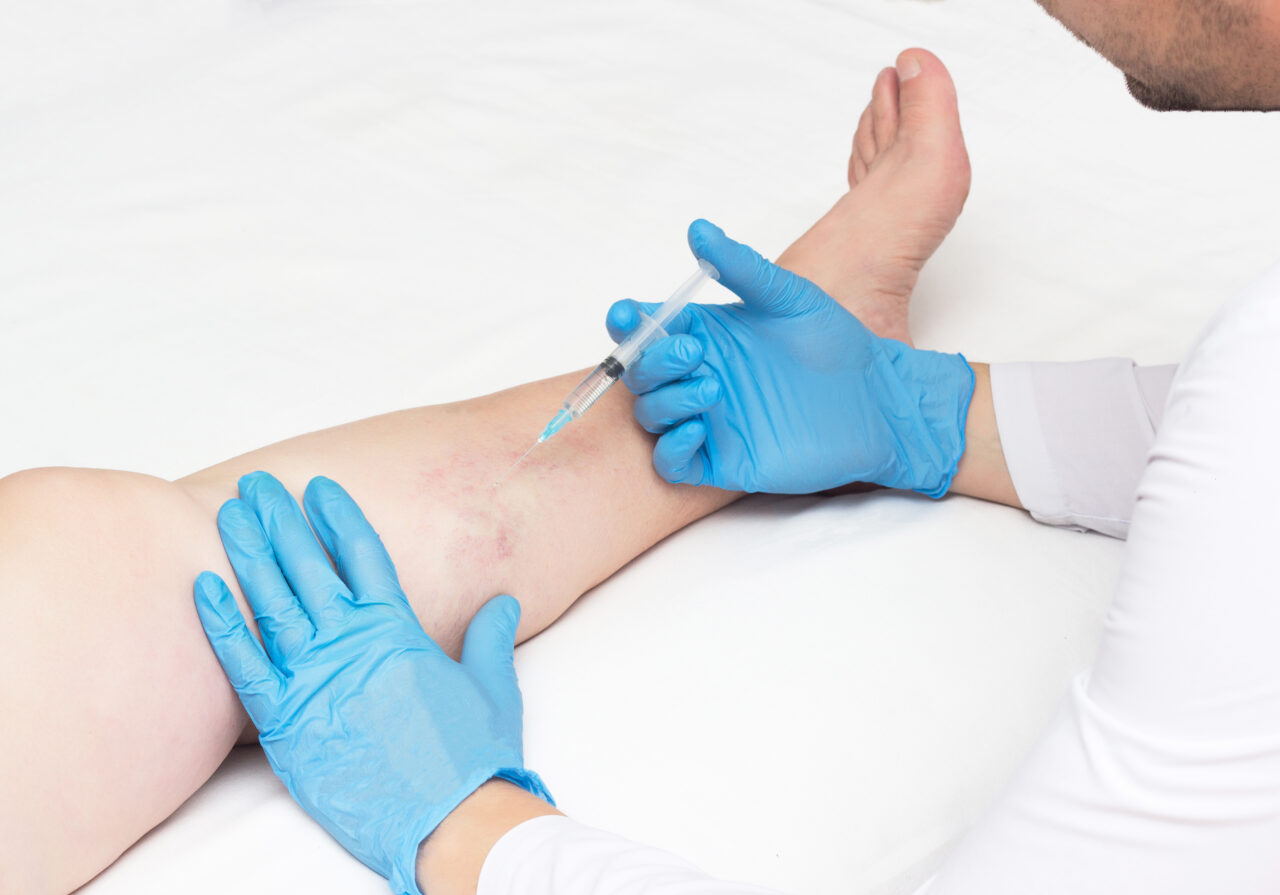What is Venous Insufficiency?

Venous insufficiency refers to a condition where the blood flow in your leg veins is impaired. This can happen when the veins’ valves become weakened or damaged, which causes blood to flow backward instead of upwards towards the heart. As a result, blood pools in the veins of the legs, leading to symptoms like swelling, pain, and skin changes.
Venous insufficiency is a common condition that affects many people in California, and it can have a significant impact on your quality of life. At California Vein Treatment, we specialize in treating venous insufficiency using minimally invasive techniques that are safe and effective.
Risk Factors for Venous Insufficiency
Several factors can increase your risk of developing venous insufficiency, including:
- Age: As you age, the risk of developing venous insufficiency increases as the valves in the veins become weaker, and the walls of the veins become less flexible. This can cause blood to flow back into the veins, leading to blood pooling, swelling, and other symptoms associated with venous insufficiency.
- Family history: If your family members have a history of venous insufficiency, you may be more likely to develop the condition. This is because venous insufficiency can be inherited, and certain genetic factors make you more susceptible to weakened vein valves.
- Medical history: Certain medical conditions can increase your risk of developing venous insufficiency, including deep vein thrombosis (DVT), which is a blood clot that forms in the deep veins of the leg. DVT can damage the valves in the veins, leading to venous insufficiency. Other medical conditions like obesity, heart disease, and diabetes can also increase your risk of developing venous insufficiency.
- Sitting or standing for long periods: If you sit or stand for long periods, you may develop venous insufficiency. This is because sitting or standing for extended periods can lead to blood pooling in the legs, which can cause the veins to stretch and the valves to weaken.
- Blood vessel damage: If you’ve had an injury or surgery that damaged your veins, you may be more likely to develop venous insufficiency. Trauma to the legs, such as a broken bone, can damage the veins and the valves, leading to blood pooling and venous insufficiency. Surgery that requires incisions or punctures can also damage the veins, leading to weakened valves and venous insufficiency.
- Other risk factors: There are other risk factors that can increase your risk of developing venous insufficiency. For example, women are more likely to develop the condition than men, especially during pregnancy and menopause. Hormonal changes can affect the veins and lead to weakened valves. Being overweight or obese can also increase your risk of developing venous insufficiency, as excess weight puts more pressure on the veins.
Symptoms of Venous Insufficiency
The symptoms of venous insufficiency can vary from person to person, and they may include:
- Swelling in the legs and ankles
- Pain or aching in the legs, especially after standing or sitting for long periods
- Skin changes, such as thickening, discoloration, or ulceration
- Varicose veins on the surface of the legs
- Leg cramps or a feeling of heaviness in the legs
- Itching or tingling in the legs
If you experience any of these symptoms, it’s important to seek medical attention. At California Vein Treatment, we can diagnose venous insufficiency using a duplex ultrasound, which is a non-invasive test that uses sound waves to create images of your leg veins.
Treatment Options for Venous Insufficiency
At California Vein Treatment, we offer a range of minimally invasive treatments for venous insufficiency, including:
- Endovenous laser ablation: Endovenous laser ablation is a minimally invasive treatment that uses laser energy to close off the affected veins. During the procedure, a small laser fiber is inserted into the vein through a tiny incision in the skin. The laser energy heats the vein, causing it to collapse and seal shut. Blood is then redirected to healthier veins, improving blood flow in the legs.

- Radiofrequency ablation: Radiofrequency ablation is another minimally invasive treatment for venous insufficiency. During the procedure, a small catheter is inserted into the affected vein through a tiny incision in the skin. The catheter delivers radiofrequency energy to the vein, causing it to heat up and collapse. Blood is then redirected to healthier veins, improving blood flow in the legs.
- Venaseal: Venaseal is a minimally invasive treatment that involves using a medical adhesive to close off the affected veins. During the procedure, a small catheter is inserted into the affected vein through a tiny incision in the skin. The catheter delivers a medical adhesive to the vein, sealing it shut. Blood is redirected to healthier veins, improving blood flow in the legs.
Our board-certified vein doctors will work with you to develop a personalized treatment plan that addresses your specific needs and concerns. We always start by diagnosing the root cause of your venous insufficiency using a duplex ultrasound, which allows us to see the blood pooling in your leg veins, following which we curate a personalized treatment plan.
Preventing Venous Insufficiency
There are several things you can do to reduce your risk of developing venous insufficiency:
- Maintaining a healthy weight
- Exercising regularly to improve blood flow in your legs
- Avoiding sitting or standing for long periods
- Elevating your legs when you’re sitting or lying down
- Wearing compression stockings to improve blood flow in your legs
If you have a family history of venous insufficiency or other risk factors, it’s important to talk to your doctor about ways to reduce your risk of developing the condition. Early intervention is key to preventing complications like venous stasis ulcers and deep vein thrombosis.
Complications of Venous Insufficiency
If left untreated, venous insufficiency can lead to several complications, including:
- Venous stasis ulcers: These are open sores that form on the skin of the legs, often around the ankles. They can be painful and difficult to heal.
- Deep vein thrombosis: This is a blood clot that forms in a deep vein in the leg. It can be life-threatening if the clot breaks loose and travels to the lungs.
- Venus bleeding: Venous insufficiency can cause bleeding from the veins in the legs.
It’s important to seek medical attention if you experience any symptoms of venous insufficiency, as early treatment can help prevent these complications.
Improving Blood Flow in Your Leg
If you have venous insufficiency, there are several things you can do to improve blood flow in your legs, including:
- Exercising regularly: This can help improve circulation in your legs and reduce swelling.
- Elevating your legs: When you’re sitting or lying down, elevate your legs above heart level to improve blood flow.
- Wearing compression stockings: These can help improve blood flow in your legs and reduce swelling.
- Avoiding sitting or standing for long periods: If you have to sit or stand for long periods, take breaks to walk around and stretch your legs.
At California Vein Treatment, we have two convenient locations in California to serve you: San Diego and San Jose. Our San Diego clinic is located in the beautiful neighborhood of La Jolla, just minutes away from the Torrey Pines beach state park and the Westfield UTC shopping center. Our San Jose clinic is located in a quiet neighborhood near Palo Alto, Sunnydale, and Santa Clara, down the block from the Santa Clara Medical Center.
Contact us today to schedule a consultation and learn more about our treatment options for venous insufficiency.
CA Vein Doctors
Meet our team of California Vein Treatment Specialists
Vein Treatments are covered by most major medical insurances, including Medicare. Call us today to verify your insurance for FREE >

Contact us
CALL US
Speak instantly with one of our team members; they will answer any questions you may have regarding insurance coverage, booking an appointment and our vein treatment locations. (858) 988-3266
BOOK APPOINTMENT
Visit our Book Appointment page and instantly request an appointment at the California vein Tretment. We offer Free Insurance Verification before your appointment.
GET DIRECTIONS
Learn how to get to one of our California vein centers in San Diego & San Jose